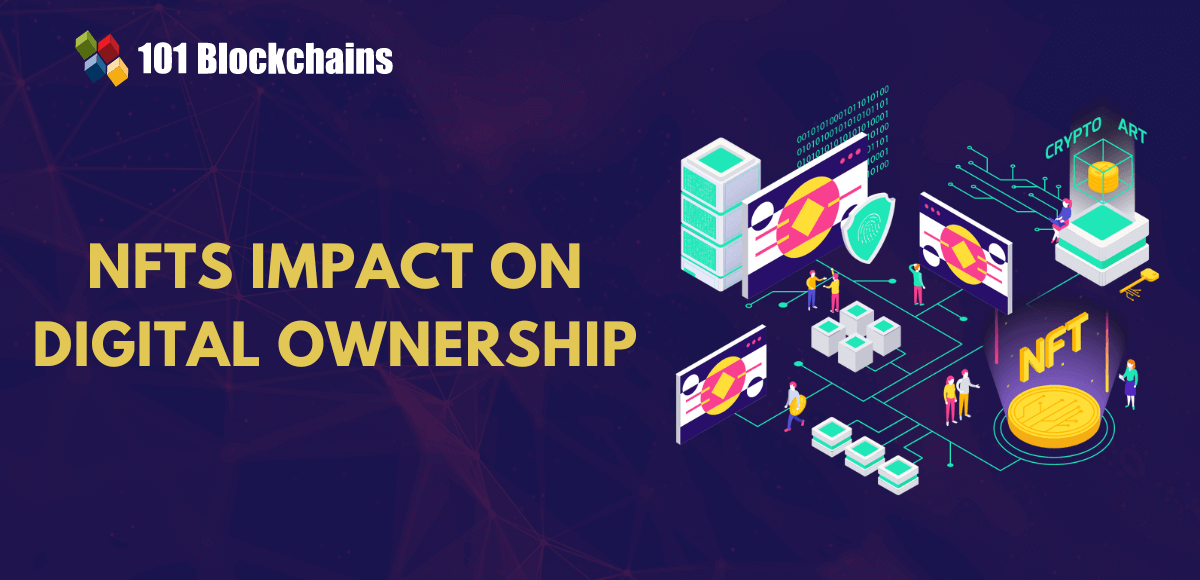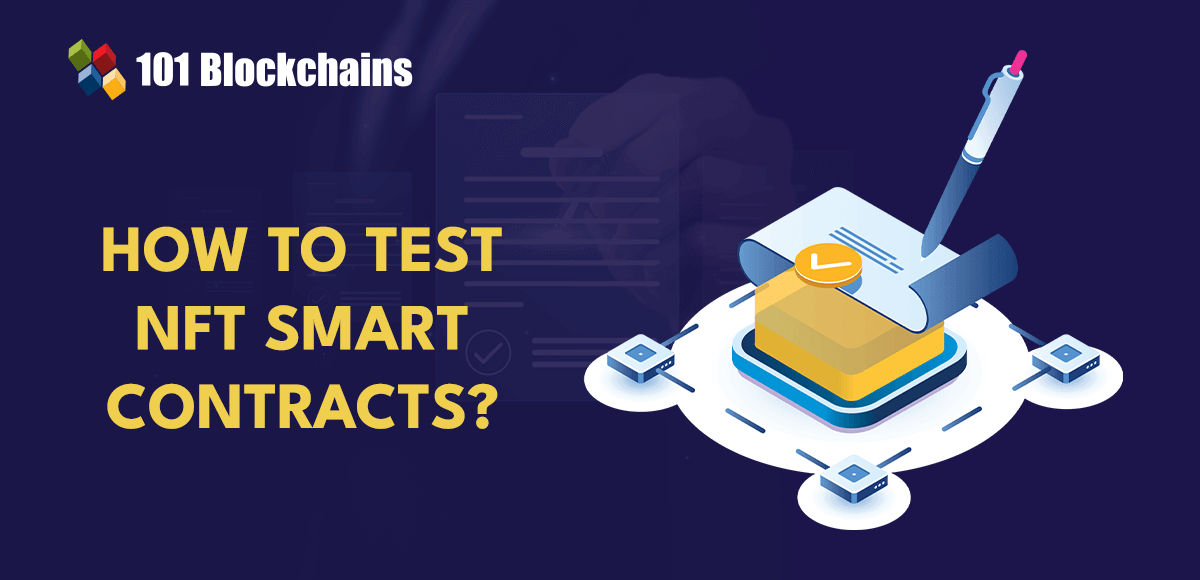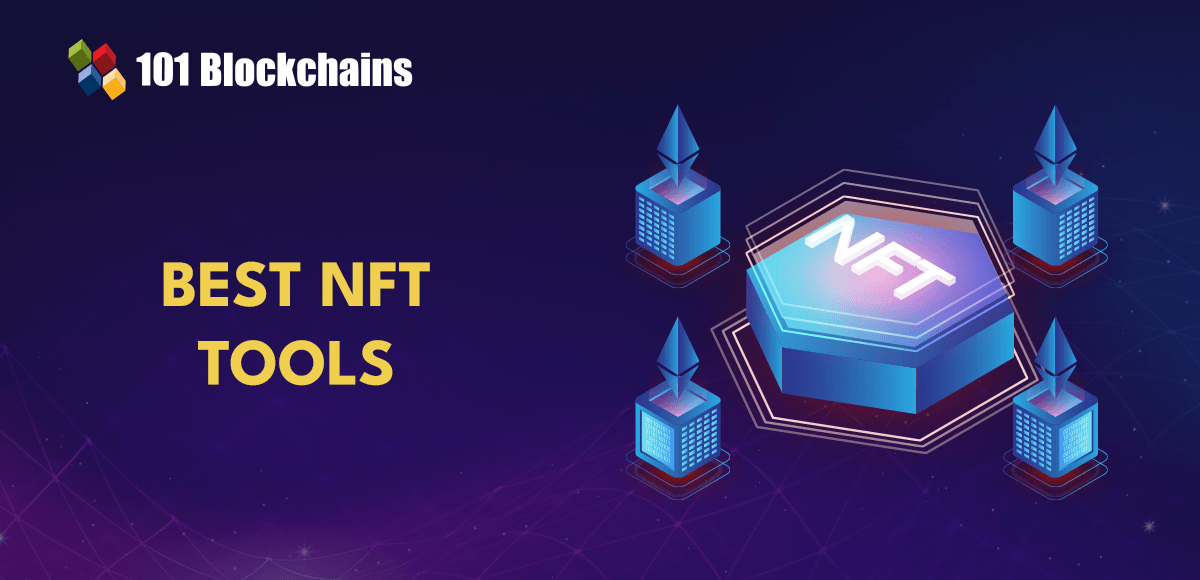Learn how blockchain truly works, master key definitions, and uncover what makes smart contracts so "smart." Dive into the fundamentals, gain valuable insights, and start your blockchain journey today!
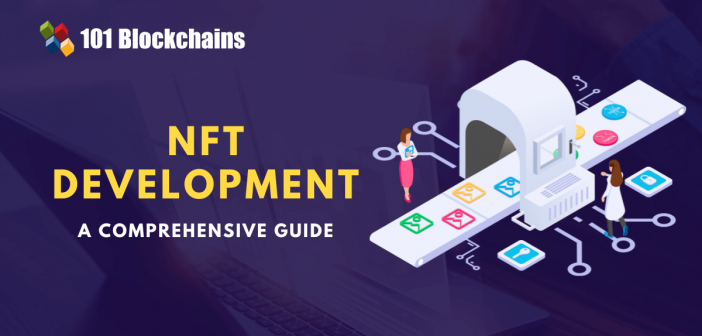
- NFT
Georgia Weston
- on December 27, 2022
A Comprehensive Guide to NFT Development
Non-fungible tokens, or NFTs, have stirred up a new revolution in the domain of digital assets. At the same time, NFTs also offer promising chances for the representation of digital asset ownership. Most important of all, non-fungible tokens present significant opportunities for the growth of the web3 landscape. Therefore, the demand for an NFT development guide has been increasing gradually in recent times. With NFTs selling for millions of dollars, anyone would reasonably seek best practices for NFT development to extract monetary benefits.
The NFT industry reached a value of around $41 billion in 2021, which implies the profitable potential of the industry. You can find many NFT development solutions which help you convert artwork and other digital files, such as audio and video content. How do you use these solutions, and what should you know before developing NFTs? The following post offers you the answer with a guide to NFT development.
Excited to develop an in-depth understanding of solidity’s best practices and the tools needed for developing and testing an NFT marketplace, Enroll now in the NFT Development Course
Importance of NFT Development
Before proceeding towards a detailed process of NFT development explained in simple terms, you should identify the importance of NFT development. Developers have recognized the potential of non-fungible tokens for inducing disruption in different sectors. NFT development utilizes blockchain technology for creating smart contracts, which represent the NFTs on the blockchain. In addition, NFT development also involves many other aspects, including a user-friendly interface for showcasing NFT asset details.
Interestingly, developers are exploring alternatives to NFT token development with opportunities in developing NFT marketplaces. On top of it, artists, content creators, and music artists also were to create non-fungible tokens, as they could exercise ownership over their works. NFTs also help in managing the benefits of secondary sales of the work of artists through royalty payments. Here are some of the significant aspects which verify the value advantages of non-fungible tokens beyond digital artwork.
- The search for a reliable NFT development tutorial would also emphasize the advantage of assurance for authenticity. Non-fungible tokens could easily prove the authenticity of a particular asset owing to the advantages of blockchain technology.
- Another advantage associated with NFTs is the ease of seamless transfers across different NFT marketplaces. Non-fungible token creators could utilize them across various platforms and use cases effortlessly.
- Before you find out a reliable NFT development platform, you must understand that NFT creators don’t have to pay intermediaries. Non-fungible tokens help you interact directly with buyers, thereby offering better returns.
- Speaking of returns, NFTs offer a viable approach to the monetization of creative works. NFT creators could explore various opportunities for obtaining monetary benefits from their work.
How Can You Choose NFT Development Platforms?
The benefits of non-fungible tokens establish solid reasons for developing NFTs. However, you can rely on development agencies to get your NFTs within no time. With a careful evaluation of essential requirements from an NFT development agency, you can identify the ideal developer for your needs.
The answers to “Where can I develop NFT?” would emphasize the projects the developer has worked on. At the same time, you can also check the tech stack used by developers alongside the services they offer. For example, NFT services include marketplace creation, NFT design and development, and marketplace creation. What are the different types of services you would require in NFT development?
NFT development may focus on creating NFT exchanges or marketplaces which can draw more users with powerful features. In addition, NFT developers can also help in creating NFT wallets, which help in storing and managing non-fungible tokens. Another important requirement for non-fungible token development focuses on fluency in the contract development standards.
Announcement – NFT Development Course Launched. Enroll today to master the art of creating digital assets
Is There Any Way You Could Create Your Own NFT?
An effective NFT development guide could help in identifying reliable development agencies for non-fungible tokens. You can also develop NFTs on your own with a clear impression of the essential requirements for NFTs. Non-fungible token smart contracts are crucial highlights in the development of these new digital assets.
As a matter of fact, the important traits of non-fungible tokens, such as non-fungibility and scarcity, have been made possible through smart contracts. The smart contract serves as a virtual agreement of the NFT with specifications of the terms and conditions in the code. The contract would execute on its own upon compliance of both parties with the terms.
Smart contracts are a critical requirement for the creation and minting of NFTs, with the facility of resilient identification information. Therefore, users could not subdivide NFTs owing to their indivisibility. Smart contracts help in ensuring the scarcity of NFTs. Furthermore, creators could also incorporate crucial information regarding NFT assets on smart contracts.
Another important highlight of NFT development explained for beginners would emphasize using smart contracts for incorporating information about the fundamental rights of the creator. For example, creators can specify the difference in ownership and copyright. In addition, NFT developers need to learn about important smart contract standards such as ERC-721 and ERC-1155 standards. On top of it, you should also emphasize comprehensive smart contract audits for identifying any bugs in the smart contract code.
Enroll now in the Certified Web3 Blockchain Developer Certification to learn about the best practices for writing, testing, and deploying Solidity smart contracts for web3 apps
Notable NFT Creation Tools
The outline of best practices for developing NFTs would also draw attention to tools for creating the tokens. As of now, the primary focus of NFT token development rests in the field of digital artwork. You can seek many powerful tools for creating NFT artwork with effective ease for beginners as well as veteran artists.
How will the NFT creation tools help you? The creation tools are effective tools for minting artwork as NFTs on the desired blockchain network. You can explore multiple creation tools in the market for developing NFT art with distinct functionalities. Therefore, it is important to identify your requirements before choosing an NFT development tool.
Some of the notable examples for answering “Where can I develop NFT?” would include answers such as Mintable, SketchAR, DropKit, and Fotor NFT Creator. Prior to the selection of a tool, you have to emphasize critical factors in the NFT creation tools. The factors include programmed watermarks, tools and templates, editing capacity, and precision of the tool.
Technology Stack Required for NFT Development
The next important concern in NFT development would focus on the selection of the technology stack. What are the technologies you can use in NFT development?
-
Blockchain Network
First of all, you need to identify blockchain technology for creating digital assets. You can find multiple options among blockchain networks suitable for your goals. Some of the popular choices include Ethereum, Binance Smart Chain, Solana, and Polygon. The selection of an NFT development platform can be quite confusing, especially with the advantages and pitfalls of the network. The best course of action for choosing a blockchain network would emphasize ensuring faster settlement with lower costs.
Want to learn blockchain technology in detail? Enroll Now in Certified Enterprise Blockchain Professional (CEBP) Course
-
Storefront
The next important highlight in the tech stack required for NFT development is storefront development. A storefront is similar to the landing page of websites, and an attractive storefront is essential for creating non-fungible tokens. You can also seek inspiration through the verification of multiple types of storefronts in a market. Storefronts could display important information about the NFT token, such as ownership, rates, bids, and preview.
-
Wallet
The NFT wallet is also another important aspect in responses to “How do I start NFT programming?” owing to its significance in storing and managing NFTs. A simple and easy-to-use interface for the wallet of an NFT platform can encourage better levels of mainstream adoption. In addition, it is also important to ensure that users can integrate the NFT wallet into their existing wallets.
-
Storage
Another important component in the technology stack for NFT development would emphasize NFT storage. You can find multiple options among decentralized storage platforms, including Filecoin and IPFS storage. On top of it, you should also verify whether the storage method will be suitable for your desired use cases.
IPFS storage offers better advantages in storing and managing off-chain NFT information while ensuring the security of blockchain technology. The essential highlights in an NFT development tutorial would focus on the secure storage of NFT data. Therefore, the storage system for your NFT marketplace solution must include essential features such as simpler API and effective retrieval. On top of it, it must also feature an effective key manager for secure and flexible access to NFT files.
Want to learn how to design and develop secure blockchain systems and distributed applications? Enroll Now in Certified Blockchain Security Expert (CBSE) Course
Essential Steps Required in NFT Development
The importance of NFT development and the required technology for creating an NFT marketplace offers an impression of the “why” and “what” of creating NFTs. Now, you must reflect on the “how” of NFT development by following a specific workflow based on the recommendations of experts.
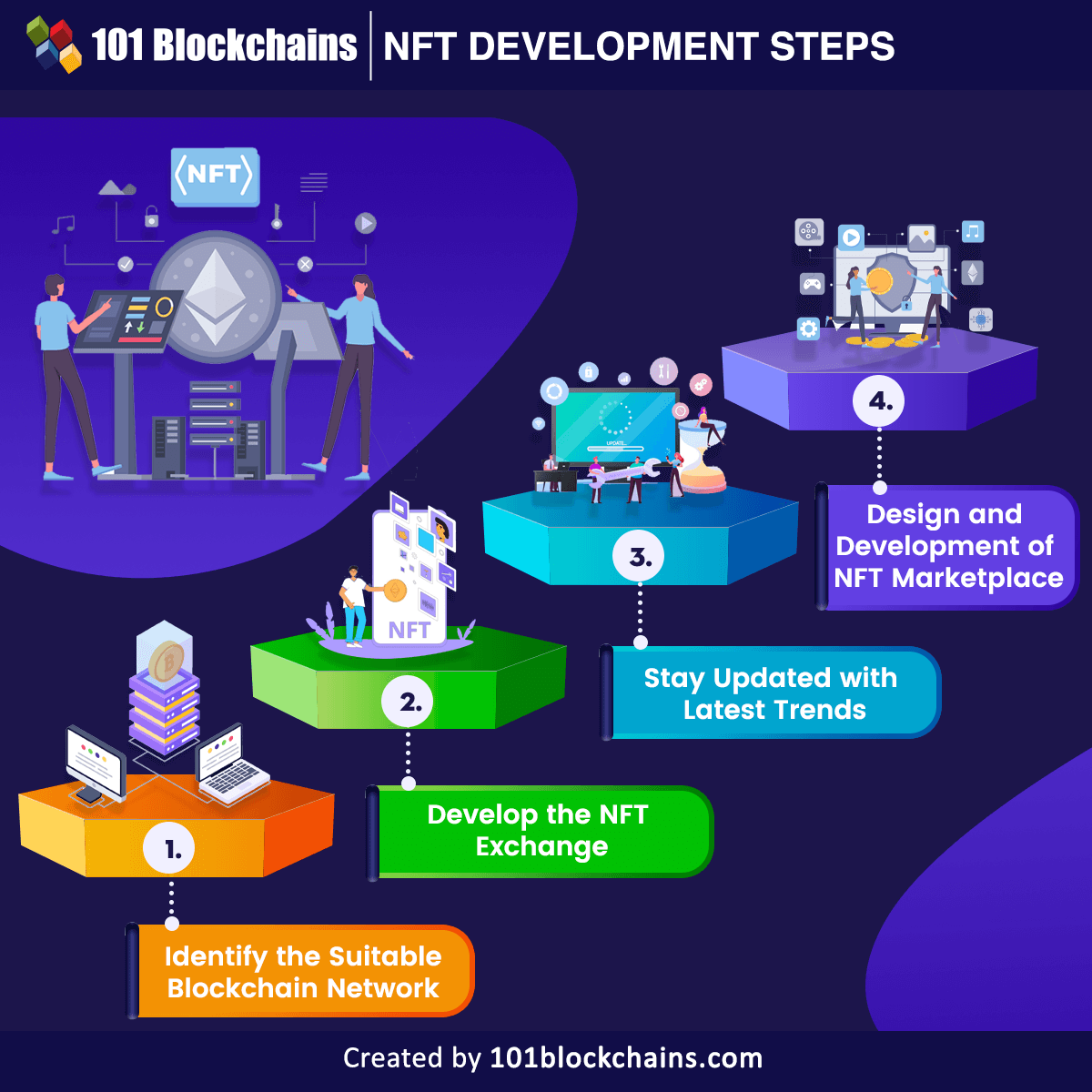
1. Identify the Suitable Blockchain Network
The outline of steps for NFT development explained in detail would start with a selection of blockchain networks. You can come across multiple networks for developing NFTs, with some of the popular options including Ethereum, EOS, and NEO. Start with the development of NFT by incorporating fundamental NFT data in the assets, such as name, digital signatures, and defined supply.
The next step in developing NFT would focus on adding significant functionalities for the non-fungible token, such as transferability. Subsequently, you should utilize different tools to ensure desired functionality of the non-fungible token.
2. Developing the NFT Exchange
The NFT exchange website is another important complement to the NFT token development process. NFT exchanges are crucial for facilitating the trade and sale of tokens. It is important to create a secure and easily navigable platform for welcoming in more users.
3. Stay Updated with Latest Trends
Another important aspect of non-fungible token development focuses on the consistent evolution of NFTs. Blockchain technology has been evolving, thereby opening up new opportunities for NFT development. For example, new cryptographic protocols or scaling solutions for expanding the usability of NFT marketplaces.
4. Design and Development of NFT Marketplace
With the right NFT development platform, you can design and create an NFT marketplace. Start with a clear impression of the project scope and develop user-centric front-end marketplaces, ideal for buyers and artists. In addition, you should also work on important additions, such as backend-powered databases alongside APIs and other essential integrations required for interacting with the decentralized ledger. Some of the important highlights you should take into account for the development of the NFT marketplace include the following.
- NFT marketplaces must feature the facility for auctions and sales. You can think of NFT marketplaces as the digital equivalents of traditional marketplaces, such as art galleries and auction houses. The NFT marketplace should enable non-fungible token creators to showcase their assets for sale in auctions or at fixed rates.
- One of the common concerns in NFT development focuses on “How do I start NFT programming?” and the best answer points to smart contracts. As a matter of fact, a major part of the programming job in NFT development focuses on smart contracts. You can develop smart contracts with the Solidity programming language. The smart contracts should specify the terms and conditions for the sale of NFTs. It is also important to pay attention to how you can deploy smart contracts on your marketplace.
- Integration of different crypto wallets is also a mandatory requirement for NFT marketplaces. Some of the popular wallets used in NFT marketplaces include WalletConnect and MyEtherWallet.
- The development of NFT marketplaces should also account for the operational costs of the marketplace. The key costs you need to consider for NFT marketplaces include energy costs alongside the transaction costs for conversion to digital currencies.
After developing and launching the marketplace, developers must pay attention to the maintenance requirements. You should develop an effective impression of the maintenance services needed in your NFT marketplace. Maintenance services include continuous monitoring and improvement of the marketplace through upgrades. For example, integration of third-party marketplace solutions. Furthermore, marketplace maintenance is also essential for the optimal continuous operations of nodes.
Are you aspiring to learn the fundamentals of the Ethereum Virtual Machine and smart contracts’ upgradability? Enroll now in the Advanced Solidity Development Course.
Additional Functions for NFT Marketplaces
The detailed overview of an NFT development guide shows the basic components you need for NFTs and NFT marketplaces. The basic components include crypto wallets, trade transaction facilities, and smart contracts for NFT ownership representation on blockchain networks. In addition, developers can also integrate additional functionalities in the NFT marketplace to make it better.
One of the promising examples of additional functionality in marketplaces is the search and listing facility. The search facility can help users discover their desired non-fungible tokens on the marketplace. Another important feature for NFT marketplaces would be a transparent view of the featured NFT collections and recent trades. You should also seek the opportunity to introduce social network functions in marketplaces, such as rating systems and followers for specific NFTs and collections.
Start learning Non-Fungible Token with World’s first NFT Skill Path with quality resources tailored by industry experts Now!
Final Words
The best pointers from an introductory NFT development tutorial show that you need multiple components to create a valuable NFT experience. Starting from wallets to marketplaces, NFT development encompasses multiple services. As non-fungible tokens become important drivers of the web3 landscape, it is important to learn how to create these assets on your own.
NFT development platforms could serve as the first option for beginners seeking entry into the NFT ecosystem. However, you can find multiple tools for creating and minting non-fungible tokens on desired blockchain networks. On the other hand, developing an NFT wallet and NFT marketplace could serve as vital support for the increasing popularity of your NFT collection. Learn more about non-fungible tokens and their uses, and become a certified NFT professional.
*Disclaimer: The article should not be taken as, and is not intended to provide any investment advice. Claims made in this article do not constitute investment advice and should not be taken as such. 101 Blockchains shall not be responsible for any loss sustained by any person who relies on this article. Do your own research!




